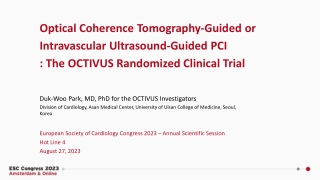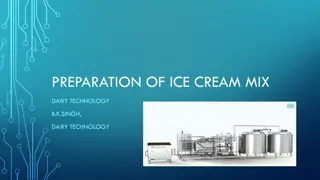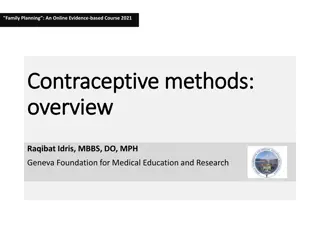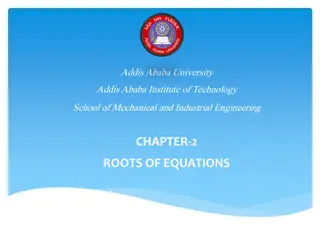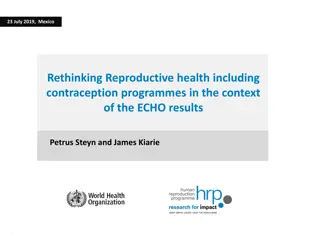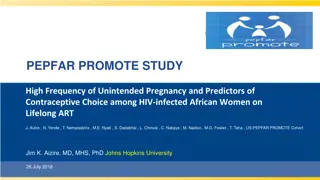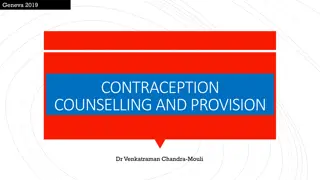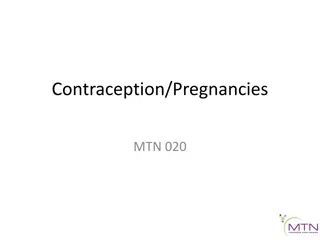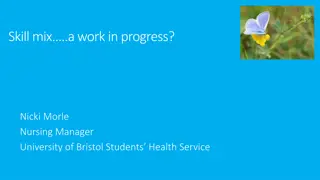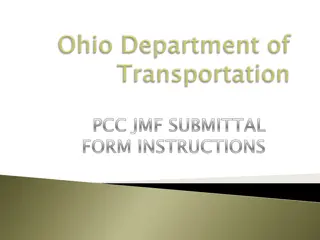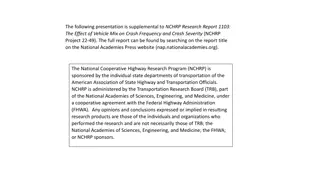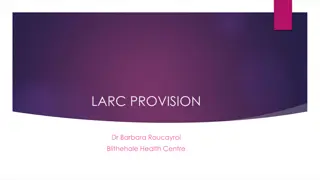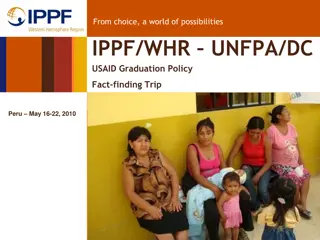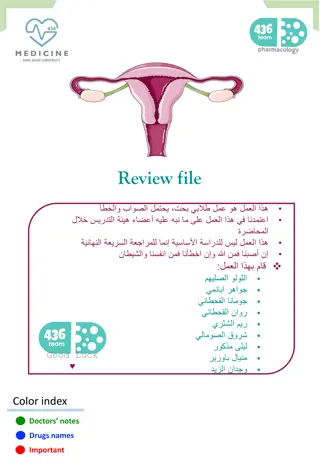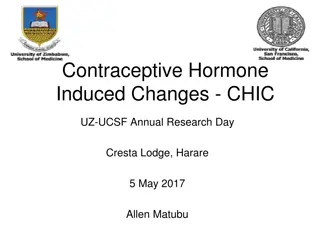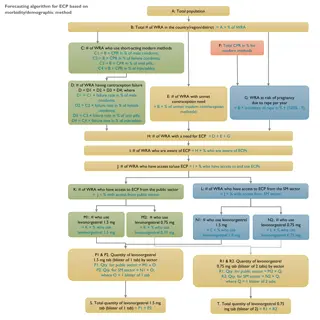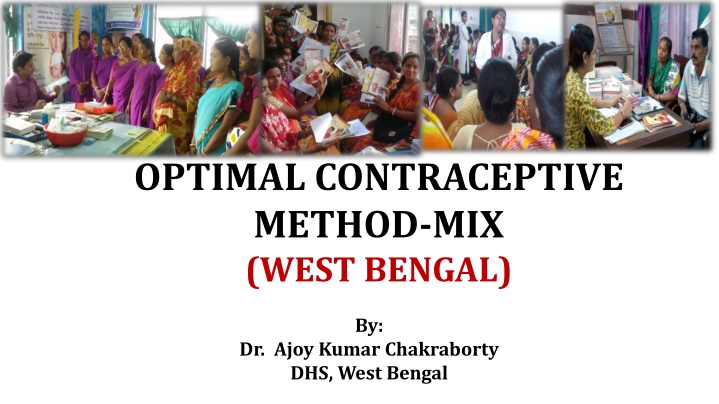
Effective Strategies for Family Planning in West Bengal
Discover how West Bengal has achieved a low Total Fertility Rate through optimal contraceptive method-mix, emphasizing the importance of family planning services for women's health and socioeconomic development. Overcoming challenges such as high teenage fertility and skewed contraceptive method mix, the state focuses on birth spacing, ensuring quality services, and increasing access to a range of contraceptive choices.
Download Presentation

Please find below an Image/Link to download the presentation.
The content on the website is provided AS IS for your information and personal use only. It may not be sold, licensed, or shared on other websites without obtaining consent from the author. If you encounter any issues during the download, it is possible that the publisher has removed the file from their server.
You are allowed to download the files provided on this website for personal or commercial use, subject to the condition that they are used lawfully. All files are the property of their respective owners.
The content on the website is provided AS IS for your information and personal use only. It may not be sold, licensed, or shared on other websites without obtaining consent from the author.
E N D
Presentation Transcript
OPTIMAL CONTRACEPTIVE METHOD-MIX (WEST BENGAL) By: Dr. Ajoy Kumar Chakraborty DHS, West Bengal
State has achieved Replacement Level Fertility of 2.1 decade back Current TFR = 1.6 (3rdlowest in the country)
The question is Do we still need Family Planning ??!!
We Realized that Access to contraceptive choices is essential to protect reproductive & sexual rights of couples. The pattern of contraceptive use and range of services provided are important indicators in this regard Access to Family Planning services is imperative in improving women s chances of surviving pregnancy and childbirth even after reaching the replacement level TFR. The next substantial gain in MMR and IMR would come from investment in Family Planning Reproductive health is critical to advancing overall health and socioeconomic development
Challenges Challenges were result of Fourth Largest Population High teenage fertility (25.3%-NFHS III) MMR (SRS) 218194 141145117113101 High use of traditional methods (21.3%-NFHS III) High MMR High 2004-06 1999-01 2001-03 2007-09 2010-12 2011-13 2014-16 Skewed contraceptive method mix Abortion/Still birth Rates (5.2%-NFHS III) High LBW (22.9%-NFHS III) Low use of contraceptive use in post-pregnancy period
States Concerted efforts Emphasis on all available contraceptiv es Focus on Birth spacing Ensuring quality of training & services Tapping post pregnancy period Improving demand for sterilization services Ensuring method continuation
Focus on Birth Spacing We Focussed on counseling, increasing access and ensuring uninterrupted supply of contraceptives till the last mile to provide wider choices Addressed misconceptions regarding IUCD locally Conducted special drives to operationalize non performing Sub-centers to provide Interval IUCD Installed Condom boxes in all health facilities for increasing access and male participation in FP WB is one of the first non Ensuring Spacing of Birth scheme states to seek assistance under NHM for implementing this scheme
Emphasis on available basket of choices We contribute to a relatively much higher share in all of the spacing methods. Combined oral contraceptive share is 23%, PPIUCD is 17% and PAIUCD is 13% which are the highest in the entire country. Antara and Chhaya have been recently introduced and rapidly holding ground West Bengal reports 3rd highest male sterilizations in the country West Bengal's contribution in India's service provision (HMIS 2017-18) 22.9 17 13.2 9.9 7.8 6.3 4.9 1.2 IUCD Injec. MPA PPIUCD Male Steri. Condom User Female Steri. PAIUCD COC User
Tapping post pregnancy period Post-Partum Services-India and Some bigger states (till Sep 2018) 98% institutional deliveries (81% of which are 60.00 50.00 at public institutes), provided 40.00 30.00 an opportunity for 20.00 10.00 0.00 expanding post partum FP services. % PPIUCD acceptance % PPS Acceptance
Tapping post pregnancy period West Bengal PPIUCD (% Acceptance out of Public Sector Deliveries) A rapid scale up of PPIUCD services from less than 1% 39.2 35.4 (2013-14) to nearly 40% at 20.7 present. 2.9 The state now leads in 0.1 0.7 PPIUCD acceptance rate in the country
Ensuring Method Continuation through quality services 12 month contraceptive discontinuation rate Strong counseling and good quality of services ensure acceptance among the people. West Bengal has one of the lowest discontinuation rate for IUCD. Discontinuation rates for OCPs and condoms is substantially low. 84.7 71.1 68.2 73 58.3 58.1 49.7 47.7 47.2 42.3 41.9 38.2 34.6 31.8 28.1 26.6 17.5 Pills IUCD Condoms
Improving Sterilization Demand Emphasis given on improving postpartum and post abortion sterilization services Stabilized fixed day approach for sterilization in all blocks throughout the State. Special drives on NSV in high focus areas through group counseling and recognizing top performing service providers
Ensuring Quality of Training Involved Medical Colleges introduction of PPIUCD, post abortion IUCD (PAIUCD) and thereby built a strong foundation for training. Similar mechanism followed introduction of newer contraceptives Capacity of Medical Officers frontline workers improved counseling and addressing side effects. Linkage between Medical College and other facilities strengthened through training partnership and hand holding. in for and for
Program rejuvenation Addressing skewed method mix- Previously, emphasis was largely on sterilization methods The state effected a paradigm shift wherein focus was given to available array of contraceptive choices. The share of spacing methods increased by 30% (NFHS I to NFHS IV) Percentage share out 18.2 48.2 of total mCPR 81.8 51.8 NFHS I Spacing methods Sterilization NFHS IV
Emphasis on the Choice- (A balanced method mix) West Bengal India Condom, 5.9 Condoms , 5.6 Oral Pills, 4.1 IUCD, 1.5 Female Sterilizat ion, 29.3 Oral Pills, 20 Male Sterilizat ion, 0.3 Female Sterilizat ion, 36 Male Sterilizat ion, 0.1 IUCD, 1.2 Analysis of the NFHS-4 data shows a balanced method mix in West Bengal for both limiting as well as spacing methods
With continued focus on FP mCPR of the state has increased from 49.9% to 57% (NFHS III to NFHS IV) (14.2% increase) (one of the largest increase in the country). The Teenage fertility rate has declined from 25.3% (NFHS III) to 18% (NFHS IV) (29% decline) Improvement in pregnancy outcomes- the incidence of low birth weight has declined from 22.9% (NFHS III) TO 16.7% (NFHS IV) (27% Decline) The traditional methods usage has declined from 21.3% to 13.9% (NFHS 3 to NFHS 4) (35% decline)
Improving the acceptance With the emphasis on quality training, intensive counselling and increasing accessibility with uninterrupted supply, we have increased the share in all the component in FP services during last 3 years (2014-15 to 2018-19 till Aug) Share of FP Methods in India, 2014- 15 to 18-19 (till Aug)
The focus on FP services resulted in yielding rich dividends: The state, each year is able to avert: 46 lakh unintended pregnancies, 1.53 lakh unsafe abortions 1500 maternal deaths* * (Source: Track 20) We hope that with continued focus on FP we would be able to achieve MMR and IMR targets quicker than envisaged.

